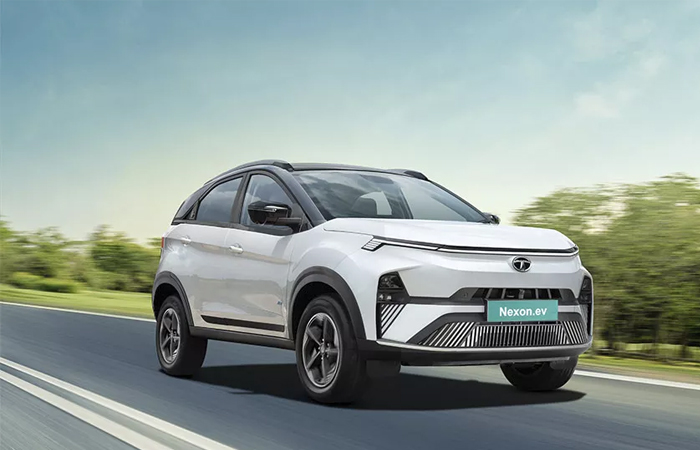Mumbai’s bustling streets are a test for any vehicle. The congestion and pothole-ridden roads demand a car that offers the right balance between performance and comfort. Enter the Tata Nexon EV’s 45 kWh model, an electric car that met these challenges and redefined my driving expectations, marking a significant milestone as my first-ever EV drive.
First Impressions: A Futuristic Aura
The Nexon EV’s design is modern yet familiar. While its aesthetics rely heavily on its ICE sibling, subtle cues like the signature DRLs, the smart digital X-factor, and the EV badge hint at its electric DNA. The seamless integration of form and function will immediately strike you as an example of Tata’s attention to detail.
Stepping inside, the cabin greeted me with a tech-forward environment. The minimalist dashboard boasted a crisp 10.25-inch infotainment screen powered by Tata’s iRA-connected car technology. The all-digital instrument cluster provided real-time data, including battery health, range estimation, and energy consumption patterns, reinforcing the futuristic appeal.
The First Push: Instant Gratification
One press of the start button and the car came to life—silently. For someone who’s used to the growl of ICE engines, this quiet activation felt almost eerie but immensely satisfying. Driving such a silent car through the chaos-ridden streets of suburban Mumbai gave me a different level of satisfaction. The real revelation, however, came when I pressed the accelerator.
The Nexon EV delivers 148 bhp of power and 215 Nm of instant torque, and I could feel every bit of it. Unlike petrol or diesel engines, where acceleration builds up gradually, the Nexon EV surged forward with remarkable immediacy. This made overtaking effortless, even in the narrow lanes of Mumbai. And the absence of engine noise heightened the sensation, making the acceleration feel like pure, unfiltered power.
Navigating Mumbai: Tech Meets Practicality
Mumbai’s streets are an eclectic mix of smooth expressways and crater-like potholes. The Nexon EV’s suspension handled this dichotomy impressively. The rear disc brakes and ESP (Electronic Stability Program) provided confidence on slippery surfaces, while the high ground clearance ensured the car could tackle speed breakers and uneven roads with ease.
One of the highlights of the drive was the car’s regenerative braking system. In the stop-and-go traffic of SV Road, I experimented with the three levels of regeneration offered. By the time I reached my destination, the battery had recuperated a small but noticeable amount of charge, extending the overall range. For city drivers, this feature is not just a novelty but a game-changer.
Range Anxiety: A Myth Debunked?
The Nexon EV’s claimed range of 489 km on a full charge is ambitious but not unrealistic for urban commutes. During the duration of my driving the car as my daily vehicle, my drives spanned about 12 kms from home to work, and they involved a mix of spirited driving and steady cruising. I had topped up the vehicle only once, and at the end of 5 days, the battery indicator showed that only around 80% of power was consumed.
The Tech Backbone
The Nexon EV is as much a tech product as it is an automobile. The iRA app integration allows for remote control of several car functions, such as pre-cooling the cabin or checking the battery status. The infotainment system deserves special mention for its responsive interface and crisp visuals. It supports both Android Auto and Apple CarPlay, seamlessly integrating with my phone. The Harman sound system was another pleasant surprise, delivering rich audio quality that elevated the driving experience.
Safety, too, has been bolstered with tech. Alongside its 5-star Global NCAP rating, the Nexon EV comes with features like a reverse parking camera, tyre pressure monitoring system (TPMS), and hill ascent/descent assist, all of which proved invaluable in Mumbai’s terrain.
Challenges and Learnings
While the drive was overwhelmingly positive, there were a few learning curves. Charging, for instance, requires planning. Although home charging is convenient for most users, apartment dwellers like me would need to rely on public infrastructure. Thankfully, Tata offers a comprehensive home installation service, which could ease this transition.
Another adjustment was adapting to the regenerative braking. The highest regen setting felt a bit too aggressive initially, slowing the car significantly as soon as I lifted my foot off the accelerator. However, after some practice, I began to appreciate how it negated the need for constant brake application.
The Bigger Picture: Sustainability Meets Performance
Driving the Tata Nexon EV was a revelation, not just because it was my first EV experience but because it shattered preconceived notions about electric vehicles being less capable or boring to drive. The Nexon EV proved that sustainable driving need not come at the cost of performance or convenience.
Moreover, the financial incentives tied to EVs—lower running costs, government subsidies, and reduced road taxes—make it an attractive proposition for city dwellers. Over time, these benefits could offset the higher initial cost of purchase compared to ICE cars.
Final Thoughts: A Glimpse into the Future
As I handed over the Nexon EV after my drives through Mumbai, I couldn’t help but reflect on the paradigm shift it represents. This isn’t just a car; it’s a statement about where the future of mobility is headed. Silent, powerful, and packed with tech, it’s a compelling argument for EV adoption.
For a tech enthusiast, the car is a playground of innovation. For a city driver, it’s a practical and sustainable solution. The Tata Nexon EV doesn’t merely adapt to Mumbai’s challenges—it thrives in them, making it a worthy companion for the urban jungle.


